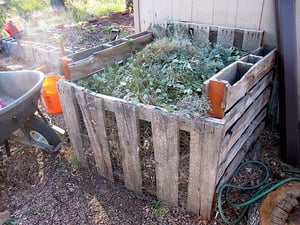 Getting Started with Backyard Composting
Getting Started with Backyard Composting
Find an area in your yard that is approximately one cubic yard (3’x3’x3’). If the pile is too small it will not hold enough heat for microbial activity and piles too large do not allow enough air to filter through.
Get the Proper Green & Brown Balance In Your Backyard Compost
Your compost should contain equal parts green and brown material. To thrive you must feed your pile, nitrogen, carbon, water, and air. Brown items, such as branches, twigs, straw, and dead leaves, contribute carbon. Green ingredients, including vegetable and fruit waste, tea bags, eggshells, and coffee grounds all provide nitrogen.
Create Your Compost
1. Mix two parts brown with one part green to provide a good mixture of carbon and nitrogen.
2. Chop twigs and break up fruits and vegetables to help the materials break down more quickly.
3. Check moisture and add water as needed. It’s important for the compost to stay moist but not too soggy.
4. Turn your compost regularly. Turning your compost will help with breakdown and air flow.
5. Use the finished compost to feed your garden!
Quick Tip: The smaller the pieces you put in your compost pile, the more quickly they decompose.
Tips for Backyard Composting In the Mountains
Mix
Mixing compost weekly can produce finished compost in 2-3 months in our area. Not mixing will take about 2 years to produce finished compost. Choose which best fits your lifestyle, and keep in mind that kitchen scraps (green stuff) always need to be mixed with brown stuff, not just placed on top of the pile, or pests may be attracted to your compost.
Provide Air
Lack of air will cause decomposition to be performed by anaerobic bacteria, which stink and decompose waste very slowly. This is another reason to mix your pile (it adds air pockets).
Check Moisture Levels
Your pile should be as moist as a wrung out sponge– not dripping wet, but moist. Too much water will cause your compost to lose nutrients and could create anaerobic conditions so the pile will stink and work slowly. Too little water will cause the good microorganisms to go dormant and decomposition will be very slow.
Proper Pile Size
Generally the pile should be between 3’x3’x3’ and 5’x5’x5’. But there are ways around this. If the pile is less than 3’ square it will be harder to reach the high temperatures, so mixing becomes more important and the bin should be insulated using foam board, straw bales, or some other insulator.
Chop, Shred & Tear
This will help increase the surface area available for microorganisms to chop up the items. Be sure to not over do it– if everything is chopped up into very tiny pieces it is hard to keep air pockets in the pile, forcing the pile into stinky & slow anaerobic decomposition.
Pile Location
If possible keep the pile out of direct sun and high winds, which will dry it out. Keep it close to a water source for convenience. Be sure that the area has good drainage (you don’t want the pile to sit in standing water). Keep in mind:
Compost piles will break down wood and trees, do not place it against a building or over exposed tree roots!








